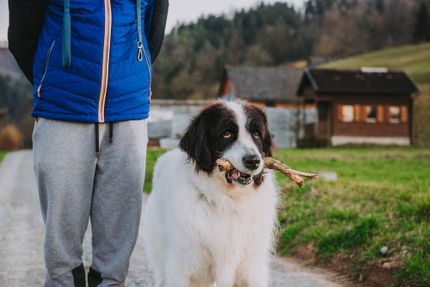Cavapom:Cavalier King Charles Spaniel and Pomeranian Mix
Facts & Origin
Cavalier King Charles Spaniel and Pomeranian mix - a hybrid breed.
This sweet little guy is a mix of Cavalier King Charles Spaniel and Pomeranian. He has the best of both worlds and a loving and playful personality!
Mixed breeds between Cavalier King Charles Spaniel and Pomeranian are small dogs that show a combination of traits from both parents. They are usually loving, lively and affectionate and make good family dogs. Although small, they are active and need regular exercise and mental stimulation. They are also known to get along well with children and other pets. Their long, soft coats require regular grooming to stay in good condition. In general, these dogs are hardy and have a life expectancy of about 12 to 15 years.
| Alternate Name | - |
| Origin | England - Germany |
| Life expectancy | 9 - 16 years |
| Care requirements | low-maintenance - high-maintenance |
| Activity level | low |
| FCI group | not recognised |
| AKC group | not recognised |
| KC group | not recognised |
More Cavalier King Charles Spaniel mixes
More Pomeranian mixes
Attitude, character and temperament of the breed
Possible character traits of Cavalier King Charles Spaniel and Pomeranian Mix - Such is probably his nature.
Cavalier King Charles Spaniel and Pomeranian Mix: The ultimate small dog
A Cavalier King Charles Spaniel and Pomeranian mix is a great companion for anyone living in small apartments or houses. They are also ideal for senior* citizens or people with limited mobility, as they don't need a lot of exercise.
These dogs are known to be very affectionate and loving. They enjoy being around their humans and are known to form strong bonds. They make great lap dogs and love to snuggle with you on the sofa.
Cavalier King Charles Spaniels and Pomeranians were both bred to be companion dogs, so it's no surprise that they get along great! These dogs get along well with other animals and make excellent family dogs.
The Cavalier King Charles Spaniel and Pomeranian are a hypoallergenic breed, meaning they are less likely to trigger allergies in people who are sensitive to pet dander.
Although they are small, Cavalier King Charles Spaniels and Pomeranians are not shy dogs. They are confident and have no problem standing up for themselves. They make excellent watchdogs and will warn you of strangers approaching by barking.
Cavalier King Charles Spaniels and Pomeranians are relatively low maintenance. They don't need to be bathed often, but they do need to be brushed regularly to prevent matting and tangles. Their long ears also need to be cleaned regularly to prevent infections.
If you are looking for a small, loving and affectionate companion dog, a Cavalier King Charles Spaniel and a Pomeranian mix could be the perfect breed for you!
Character
Usage


Health and breeding information
What diseases can occur in Cavalier King Charles Spaniel and Pomeranian Mix.
The Cavalier King Charles Spaniel Pomeranian mix is a popular companion dog. They are known for being intelligent, loving and playful. However, like all dogs, they are prone to certain health problems.
These dogs are relatively healthy, but as with all breeds, there are some health issues to watch out for. Some of the most common health problems include mitral valve disease, eye problems, and patellar luxation.
Other health problems in Cavaliers include heart disease, eye problems, and patellar luxation (dislocated kneecaps). Heart disease is the leading cause of death in Cavaliers, and it is estimated that more than half of all Cavaliers will develop some form of heart disease during their lifetime. The most common heart disease in Cavaliers is mitral valve disease, which is a degeneration of the mitral valve of the heart.
Eye problems are also common in Cavaliers. Approximately 30% of all Cavaliers will develop some form of eye disease during their lifetime. The most common eye problems that occur in Cavaliers are cataracts and retinal dysplasia. Patellar luxation is also relatively common in Cavaliers, affecting approximately 20% of all Cavaliers.
Although these health problems are most common in Cavaliers, it is important to remember that each dog is an individual and can be affected by a variety of health problems. Therefore, it is important to take your Cavalier to the veterinarian for regular checkups and to watch for any health changes.
What does this mixed breed look like?
This Cavalier King Charles Pomeranian mixed breed has orange and white fur, which is long and wavy. The coat is thick and dense and makes this dog look very regal and elegant.
What are breed characteristics of this mix dog?
The Cavalier-Pomeranian mix is a small dog breed that typically weighs between 4-8 kg and has a body length of 20-30 cm. The breed has a short, sturdy build with a round head, large eyes and small, erect ears. The coat is dense and long, with a thick ruff. Common coat colors are black, white, brown and silver.
A cross between a Cavalier King Charles Spaniel and a Pomeranian could have a variety of div. looks, as a dog's appearance is the result of genes from both parents and is therefore unpredictable. However, it is likely that the dog will have a smaller size, as both breeds are among the smaller dog breeds. The dog could also show characteristic traits from both breeds, such as a long, soft coat and round, affectionate muzzle typical of Cavalier King Charles Spaniels, and a compact, athletic build and bushy tail typical of Pomeranians. It is difficult to be more specific about what the dog will look like without actually seeing it.
| Fur length | medium - long |
| Fur | flat coated |
| Ear shape | Floppy Ear - Standing Ears |
| Tail | fanned out - rolled up |
| Anatomy | - |
| Size ♀ | 12 - 33 cm |
| Weight ♀ | 2 - 8 kg |
| Size ♂ | 17 - 33 cm |
| Weight ♂ | 2 - 8 kg |
| Suitable For | Beginner, Children, Seniors |
Known Diseases
valvular insufficiency
Heart valve diseases in dogs are among the most common heart diseases. Most often it is an acquired change in a heart valve.
Mitral Valve Diseas (MVD)
Mitral valve disease in animals and dogs, respectively
Curly Coat Dry Eye
Eye disease in dogs.
Kidney disease
Symptoms of kidney disease in dogs: increased urination (polyuria) increased water intake. Inflammation of the mucous membrane of the mouth. Loss of appetite
Eye infections
Chronic eye infections can be very painful in dogs and can be treated with medication. In rare cases, the cornea must be treated.
Elbow dysplasia (ED)
Elbow joint dysplasia is a chronic disease complex of the elbow joint of fast growing dog breeds.
Heart disease
Can occur frequently in dogs and can sometimes be treated with medication.
Hip dysplasia (HD)
The hip dysplasia or hip joint dysplasia of the dog (HD) is a maldevelopment of the hip joint.
Patellar luxation
Patellar luxation is the term used to describe a displacement of the kneecap, which is one of the most common causes of lameness in dogs.
Numbness
Often occurs in old age.
FAQ
-
A Cavapom is a cross between two purebred dogs, the Cavalier King Charles Spaniel and the Pomeranian.
-
A Cavalier-King Charles Spaniel-Pomeranian mix can take on many different physical characteristics of its parent breeds. However, most mixed breeds have a small to medium sized build with a round head, floppy ears and a dense, fluffy coat.
-
A Cavalier King Charles Spaniel and a Pomeranian mix usually weighs between 4-8 kg and has a body length of 20-30 cm.
-
The average life expectancy of a Cavalier-King Charles Spaniel-Pomeranian mix is 12 to 15 years.
-
Yes, Cavalier King Charles Spaniel and Pomeranian mixes make great family dogs! They are usually very friendly, loving and affectionate dogs that fit well in a home with children and other pets.
Useful Articles
You can find articles that might interest you in the dogbible blog to match your favorite breed.
Visit our magazineto stay up to date on dog trends.
To find out more, view our Privacy Policy
Find here the breed that suits you and find out what character traits it has. Here you can also learn more about the origin, size and weight of your favorite breeds.
Matching your favorite breed, you'll find articles that might interest you on the dogbible dog blog.
Kong filling - recipes for really tasty Kong fillings
Hiking with dog in Saxon Switzerland
Dog kennel: building, buying, advantages, tips

















